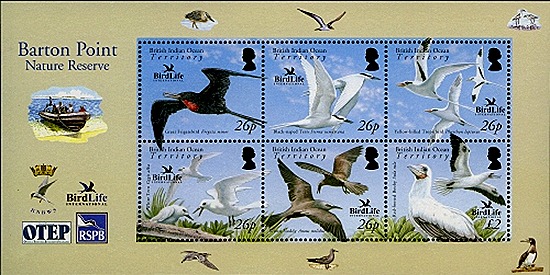
In year 2006 , BIOT (British Indian Ocean Territory) Post collaborated with Birdlife International Organization have released the stamp set features the protected seabirds Great frigatebird, Black-naped tern, Brown Noddy, Yellow-billed tropicbird, Red-footed Booby and White Tern . The issue stamps are present in one miniature sheet which consist of six postage stamps depicted the foresaid species.The sheet have marked with many logos of bird association, OTEP, RSPB, Birdlife International.
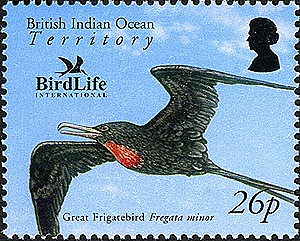

Great Frigatebird or Fregata minor
The Great Frigatebird is a large dispersive seabird in the frigatebird family, have distinctive a measure of 85–105 cm with long pointed wings of 205–230 cm and long forked tails. Major nesting populations are found in the Pacific (including Galapagos Islands) and Indian Oceans, as well as a population in the South Atlantic.
The Great Frigatebird is a lightly built large seabird with predominantly black plumage. The species exhibits sexual dimorphism. The female is larger than the adult male and has a white throat and breast, and the male's scapular feathers have a purple-green sheen. This species have a long life span around 35 years, exhibit deferred maturity, lay only 1 egg, and have a very slow-growing chick.
The Great Frigatebirds are seasonally monogamous, with a breeding season that can take two years from mating to the end of parental care. The species is colonial, nesting in bushes and trees (and on the ground in the absence of vegetation) in colonies of up to several thousand pairs.
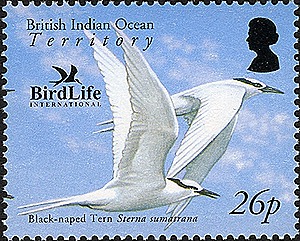

Black-naped Tern or Sterna sumarrana
The Black-naped Tern (Sterna sumatrana) is an oceanic tern mostly found in tropical and subtropical areas of the Pacific and Indian Oceans. It is rarely found inland. Their beaks and legs are black, but the tips of their bills are yellow. This species of terns is a slender bird, about 30 cm long with a wing length of 21–23 cm, with narrow wings and a distinct long forked tail.
Its name is attributed to the presence of a thin black band across its eyes that broadens around the nape, giving it a masked appearance. Its color is predominantly white with a pale grey wash on its upper parts. Both sexes are alike and its breeding plumage can be distinguished by a pinkish tinge to its under-parts and a broader black band. The call is a high-pitched "kee kee" uttered a few times in flight.
Black-naped Terns nest in small colonies and usually do not nest with other tern species, although they may be associated with nesting colonies of Roseate Terns (Sterna dougalli). They lay their eggs directly on rocky surfaces on cliffs or on the ground in a slight depression above tide level with no nesting material. However, bits of rocks are sometimes used to encircle the eggs. One or two eggs are laid and these are light buff or pale greenish in colour with rough blotches of brown or black.
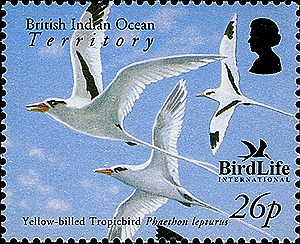

Yellow-billed Tropicbird or Phaethon Iepturus
The distinct features of White-Tailed Tropicbird or Yellow-billed Tropicbird are a graceful seabird with pointed wings and very long central tail feathers; mainly white plumage, with black markings through eye and on upper wings.
Yellow-billed Tropicbird’s habitat on small, remote oceanic islands; spends most of time roaming the open ocean; also seen along coasts. It found almost all tropical and subtropical oceans apart from eastern Pacific Ocean. Its habits are usually, breeds in loose island colonies; wanders widely across oceans when not breeding; catches fish by plunge-diving. The major populations of Yellow-billed Tropicbird are in Caribbean and Indian Ocean, especially around Christmas Island.
Yellow-billed Tropicbird nests mainly on inaccessible cliff faces, in crevices or sheltered scrapes in soil, sometimes in tree hollows or other sites.In nest lays 1 egg and the incubation period around 40 days. The young bird fledge after 70 to 85 days. It sounds loud whistles and harsh screams, especially during courtship. Their diets are mainly small flying fish and squid; some crabs and other invertebrates.
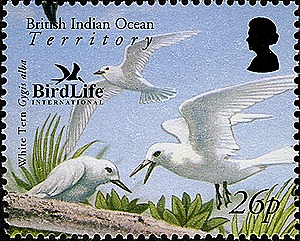

White Tern or Gygis alba
The White Tern (Gygis alba) is a small seabird found across the tropical oceans of the world. It is sometimes known as the Fairy Tern . It ranges widely across the Pacific and Indian Oceans and also nests in some Atlantic islands
The White Tern have distinctive feature is a long black bill, related to the noddies. It nests on coral islands, usually on trees with thin branches but also on rocky ledges and on man-made structures. The White Tern feeds on small fish which it catches by plunge diving.
In spite of these benefits there are costs associated with tree nesting, as the eggs and chicks are vulnerable to becoming dislodged by heavy winds. For this reason the White Tern is also quick to relay should it lose the egg. The newly hatched chicks have well developed feet with which to hang on to their precarious nesting site. It is a long-lived bird, having been recorded living for 17 years.
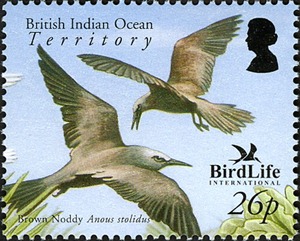

Brown Noddy or Anous stolidus
The Brown Noddy or Anous stolidus is a medium tern from the tern family. The closely related species is Black Noddy, but the Brown Noddy is larger size and its plumage color dark brown rather than black.The Brown Noddy is the largest member of the noddy family; they weigh twice as much as black noddies.
The other distinctive are white forehead blending to gray nape, and small white (lower) half-eye ring. Wedge shaped tail has small notch at tip. Black bill is long, slender. Black legs, feet. Strong, swift flight with steady wing beats. Often flies with erratic changes of direction.
The Brown Noddy is a tropical seabird with a worldwide distribution, ranging from Hawaii to the Tuamotu Archipelago and Australia in the Pacific Ocean, from the Red Sea to the Seychelles and Australia in the Indian Ocean and in the Caribbean to Tristan da Cunha in the Atlantic Ocean.
The Brown Noddy is colonial, usually nesting on the in elevated situations on cliffs or in short trees or shrubs. It only occasionally nests on the ground. A single egg is laid by the female of a pair each breeding season.
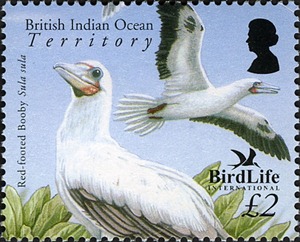

Red-footed Booby or Sula sula
The Red-footed Booby (Sula sula) is the smallest of all boobies at about 70 centimetres in length and with a wingspan of up to 1 metre. As suggested by the name, adults always have red feet, but the colour of the plumage varies.Its bill and throat pouch are coloured pink and blue. The sexes are similar.
They are powerful and agile fliers, but they are clumsy in takeoffs and landings. They are found widely in the tropics, and breed colonially in coastal regions, especially islands. Red-footed Boobies are spectacular divers, plunging into the ocean at high speeds to catch prey. They mainly eat small fish or squid which gather in groups near the surface.
This species has several morphs. In the white morph, the plumage is mostly white and the flight feathers are black. The brown morph is overall brown. The white-headed and white-tailed brown morph has a mostly white body, tail and head, and brown wings and back. The morphs commonly breed together, but in most regions one or two morphs predominate.
It nests in large colonies, laying one chalky blue egg in a stick nest, which is incubated by both adults for 44–46 days. The nest is usually placed in a tree or bush, but rarely it may nest on the ground.
Red-footed Booby pairs may remain together over several seasons. They perform elaborate greeting rituals, including harsh squawks and the male's display of his blue throat, also including short dances.
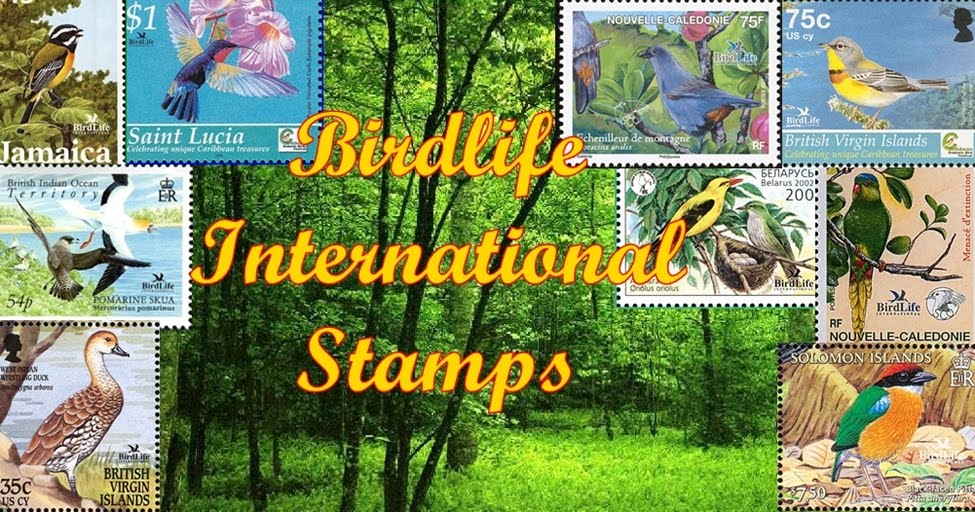
Thanks for your comment
ReplyDeleteWhat about stamps issued by india post?
ReplyDelete